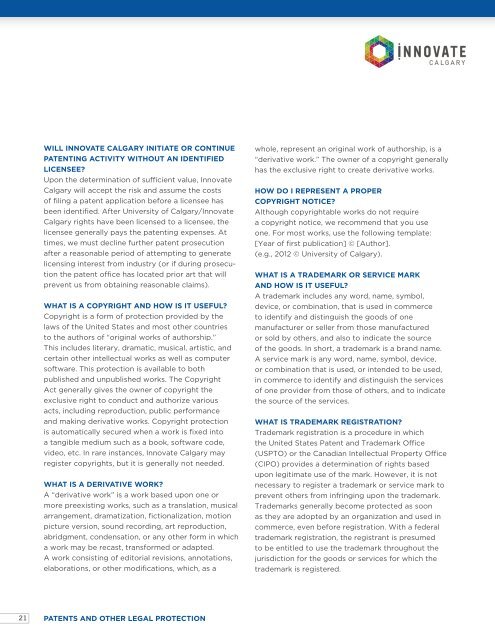INVENTOR'S HANDBOOK CALGARY'S - University of Calgary
INVENTOR'S HANDBOOK CALGARY'S - University of Calgary
INVENTOR'S HANDBOOK CALGARY'S - University of Calgary
You also want an ePaper? Increase the reach of your titles
YUMPU automatically turns print PDFs into web optimized ePapers that Google loves.
Will Innovate <strong>Calgary</strong> initiate or continue<br />
patenting activity without an identified<br />
licensee?<br />
Upon the determination <strong>of</strong> sufficient value, Innovate<br />
<strong>Calgary</strong> will accept the risk and assume the costs<br />
<strong>of</strong> filing a patent application before a licensee has<br />
been identified. After <strong>University</strong> <strong>of</strong> <strong>Calgary</strong>/Innovate<br />
<strong>Calgary</strong> rights have been licensed to a licensee, the<br />
licensee generally pays the patenting expenses. At<br />
times, we must decline further patent prosecution<br />
after a reasonable period <strong>of</strong> attempting to generate<br />
licensing interest from industry (or if during prosecution<br />
the patent <strong>of</strong>fice has located prior art that will<br />
prevent us from obtaining reasonable claims).<br />
What is a copyright and how is it useful?<br />
Copyright is a form <strong>of</strong> protection provided by the<br />
laws <strong>of</strong> the United States and most other countries<br />
to the authors <strong>of</strong> “original works <strong>of</strong> authorship.”<br />
This includes literary, dramatic, musical, artistic, and<br />
certain other intellectual works as well as computer<br />
s<strong>of</strong>tware. This protection is available to both<br />
published and unpublished works. The Copyright<br />
Act generally gives the owner <strong>of</strong> copyright the<br />
exclusive right to conduct and authorize various<br />
acts, including reproduction, public performance<br />
and making derivative works. Copyright protection<br />
is automatically secured when a work is fixed into<br />
a tangible medium such as a book, s<strong>of</strong>tware code,<br />
video, etc. In rare instances, Innovate <strong>Calgary</strong> may<br />
register copyrights, but it is generally not needed.<br />
What is a derivative work?<br />
A “derivative work” is a work based upon one or<br />
more preexisting works, such as a translation, musical<br />
arrangement, dramatization, fictionalization, motion<br />
picture version, sound recording, art reproduction,<br />
abridgment, condensation, or any other form in which<br />
a work may be recast, transformed or adapted.<br />
A work consisting <strong>of</strong> editorial revisions, annotations,<br />
elaborations, or other modifications, which, as a<br />
whole, represent an original work <strong>of</strong> authorship, is a<br />
“derivative work.” The owner <strong>of</strong> a copyright generally<br />
has the exclusive right to create derivative works.<br />
How do I represent a proper<br />
copyright notice?<br />
Although copyrightable works do not require<br />
a copyright notice, we recommend that you use<br />
one. For most works, use the following template:<br />
[Year <strong>of</strong> first publication] © [Author].<br />
(e.g., 2012 © <strong>University</strong> <strong>of</strong> <strong>Calgary</strong>).<br />
What is a trademark or service mark<br />
and how is it useful?<br />
A trademark includes any word, name, symbol,<br />
device, or combination, that is used in commerce<br />
to identify and distinguish the goods <strong>of</strong> one<br />
manufacturer or seller from those manufactured<br />
or sold by others, and also to indicate the source<br />
<strong>of</strong> the goods. In short, a trademark is a brand name.<br />
A service mark is any word, name, symbol, device,<br />
or combination that is used, or intended to be used,<br />
in commerce to identify and distinguish the services<br />
<strong>of</strong> one provider from those <strong>of</strong> others, and to indicate<br />
the source <strong>of</strong> the services.<br />
What is trademark registration?<br />
Trademark registration is a procedure in which<br />
the United States Patent and Trademark Office<br />
(USPTO) or the Canadian Intellectual Property Office<br />
(CIPO) provides a determination <strong>of</strong> rights based<br />
upon legitimate use <strong>of</strong> the mark. However, it is not<br />
necessary to register a trademark or service mark to<br />
prevent others from infringing upon the trademark.<br />
Trademarks generally become protected as soon<br />
as they are adopted by an organization and used in<br />
commerce, even before registration. With a federal<br />
trademark registration, the registrant is presumed<br />
to be entitled to use the trademark throughout the<br />
jurisdiction for the goods or services for which the<br />
trademark is registered.<br />
21 PATENTS AND OTHER LEGAL PROTECTION

















